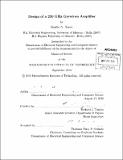Design of a 250 GHz gyrotron amplifier
Author(s)
Nanni, Emilio A. (Emilio Alessandro)
DownloadFull printable version (11.31Mb)
Alternative title
Design of a two hundred fifty gigahertz gyrotron amplifier
Other Contributors
Massachusetts Institute of Technology. Dept. of Electrical Engineering and Computer Science.
Advisor
Richard J. Temkin.
Terms of use
Metadata
Show full item recordAbstract
A design is presented of a 250 GHz, 1 kW gyrotron traveling wave tube (gyro-TWT) amplifier with gain exceeding 50 dB. Calculations show that the amplifier will operate at 32 kV, 1 A with a saturated gain of 60 dB, an output power of 1 kW and a gain bandwidth of 3 GHz. The amplifier uses a novel photonic band gap (PBG) interaction circuit for stable single mode operation in an overmoded circuit. The design mode is a TE03-like mode confined by the PBG lattice with no nearby competing modes. The design of the input coupler, interaction circuit, output coupler and electron gun have also been completed. The amplifier design accounts for requirements imposed by the device's intended application of pulsed nuclear magnetic resonance spectroscopy with pulses as short as several hundred picoseconds. This design will be implemented at a later date for the construction of the highest frequency, kW power level amplifier based on vacuum electronics. To gain understanding of short pulse amplification in vacuum electron devices, an experimental study of sub-nanosecond pulse amplification in a gyro-TWT has been carried out on an existing experimental setup at 140 GHz. The gyro-TWT operates with 30 dB of small signal gain in the HE06 mode of a confocal waveguide. Picosecond pulses show broadening and transit time delay due to two distinct effects: the frequency dependence of the group velocity near cutoff and gain narrowing by the finite gain bandwidth of 1.2 GHz. Experimental results taken over a wide range of parameters, with pulses as short as 400 ps, show good agreement with a theoretical model in the small signal gain regime.
Description
Thesis (S.M.)--Massachusetts Institute of Technology, Dept. of Electrical Engineering and Computer Science, 2010. Cataloged from PDF version of thesis. Includes bibliographical references (p. 105-109).
Date issued
2010Department
Massachusetts Institute of Technology. Department of Electrical Engineering and Computer SciencePublisher
Massachusetts Institute of Technology
Keywords
Electrical Engineering and Computer Science.